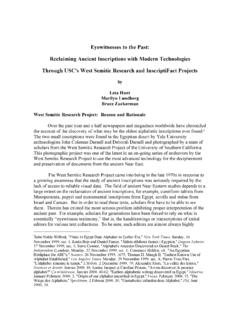Transcription of Designing for knowledge worker retention & organization ...
1 Journal of Management and Marketing Research Designing for knowledge , Page 1 Designing for knowledge worker retention & organization performance Klara Nelson The University of Tampa Joseph E. McCann Jacksonville University Abstract This paper illuminates significant relationships between three major knowledge management (KM) design dimensions and the perceived ability of 150 organizations to retain their knowledge workers. knowledge worker retention is a critical challenge for today s organizations as they face increasing global competition with its demands for even more such workers, while dramatically shifting workforce demographics hasten their exit.
2 KM design initiatives that accelerate knowledge creation, acquisition, and particularly knowledge capture, sharing and retention , are receiving unprecedented levels of investment as a result. While many factors impact organization financial performance , this research indicates that successful knowledge worker retention is significantly related with higher reported financial performance . The implications of these results are noted. Journal of Management and Marketing Research Designing for knowledge , Page 2 Introduction knowledge is always embodied in a person; carried by a person; created, augmented, or improved by a person; applied by a person; taught and passed on by a person; used or misused by a person.
3 The shift to the knowledge society therefore puts the person in the center. (Drucker, 2001, ). Retaining employees whose knowledge has high competitive value is becoming a critical and well-recognized challenge (DeLong, 2004; Frank, Finnegan, & Taylor, 2004; Jamrog, 2004; Ready & Conger, 2008; Somaya & Williamson, 2008). Such employees are known as knowledge workers in that they have high degrees of expertise, education, or experience, and the primary purpose of their jobs involves the creation, distribution or application of knowledge (Davenport 2005, ). The retention challenge is the result of increasing job mobility in the global knowledge economy where workers average six employers over the course of a career (O Neal, 2005), coupled with the baby boomer retirement brain drain and a smaller generation of workers entering their prime working age during this time (Jamrog, 2004).
4 It is occurring in all types of organizations across all management levels. This study empirically investigates whether the impact of an organization s strategic orientation toward knowledge management, the learning culture it supports, and specific human resource practices impact knowledge worker retention and organization performance . This study is important because the costs from general employee turnover are significant, ranging from 100% to 150% of a person s base salary, including separation costs, replacement costs associated with hiring and training, and lost productivity costs (Bliss, 2001). In addition to short-run financial costs, Lee and Strong (2004) describe four types of knowledge -- knowing what, knowing-how, knowing-why, and knowing-who -- that can impact long-term competitive performance when lost.
5 knowledge workers capture and apply tacit knowledge , a key to building sustainable competitive advantage (Lubit, 2001; Nahapiet & Ghoshal, 1998; Nissen 2005;Teece, 1998). The Drucker quote reminds us that knowledge workers literally own the means of production and carry knowledge , information, and know-how skills in their heads (Lagace, 2007). The social network consequences of their loss are also becoming recognized as key central connectors, brokers, and peripheral players disappear during downsizings and outsourcing exercises (Parise, Cross & Davenport, 2006). Social networks take time to re-emerge and support knowledge sharing (Coleman, 1988).
6 There are also difficult to document costs associated with the loss of critical tacit knowledge held in key individuals because such knowledge is less likely to be mentioned and transferred, and thus can be lost forever (Mohamed, Mynors, Grantham, Walsh, & Chan, 2006). Typical losses occur when talented researchers move to other companies or leave to start their own businesses. When those start-ups become sizable competitors, the costs of that lost knowledge are potentially devastating. Whether knowledge worker loss actually impacts overall financial performance has, however, been more difficult to empirically confirm (Delery, 1998; Glebbeek & Bax, 2004).
7 Turnover can have negative effects on firm performance depending on many factors that vary according to type of firm and circumstances. For example, Shaw, Gupta, and Delery (2005) found a negative relationship in one study between voluntary turnover and organization performance which was attenuated as voluntary turnover increased. In other words, the effects Journal of Management and Marketing Research Designing for knowledge , Page 3 of turnover on performance are very strong when turnover is low but weaken as turnover becomes very high and the organization is in continual workforce replacement mode (Shaw, Gupta, & Delery, 2005).
8 Similarly, employee turnover in a major retail chain was associated with poorer customer service and decreased profit margins (Zeynep & Huckman, 2008). Cascio (2006) also reported that a 10% improvement in retention at SYSCO resulted in more than $70 million of savings per year. This study attempts to identify whether a relationship does exist between retention and overall financial performance . KM Phases and knowledge Loss Exhibit 1 notes each phase of the knowledge management process, beginning with the internal creation and external acquisition of knowledge , its explicit expression, capturing and sharing, and its application in creating new or improved products and services which build performance .
9 -- Insert Exhibit 1 Here -- knowledge loss can occur within each process phase. Potentially valuable research knowledge may never be successfully linked to market opportunities when an internal R&D process is flawed. A poorly managed acquisition integration can result in key talent leaving and their knowledge not acquired. When an organization s culture and HR practices reward competitive individual behavior, key knowledge workers such as senior consultants may simply elect to not share their expertise. And, finally, whenever market research fails to accurately collaborate and learn from customers and vendors, the wrong knowledge can be applied to products and services which fail to deliver expected performance (Hoopes & Postrel, 1999).
10 A clear knowledge management goal must therefore be to minimize such knowledge losses when and wherever they occur. However, the failure to retain knowledge workers who exit an organization is a major form of loss that is growing in significance for the reasons previously noted. Designing for knowledge Management Since market demand can certainly drive knowledge worker movement, organizations are feeling an urgent need to preserve as much tacit knowledge as possible while they have them (Cappelli, 2000; Droege & Hoobler, 2003). AMR Research, for example, reported that organizations were expected to spend over $73 billion in 2007 on knowledge gathering, capturing, and sharing technologies such as portals and platforms, with spending growing nearly 16% in 2008 (McGreevy, 2007).













